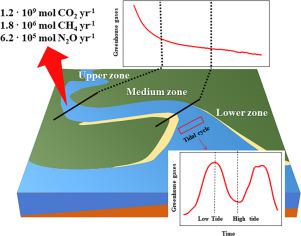Science of the Total Environment ( IF 8.2 ) Pub Date : 2021-09-11 , DOI: 10.1016/j.scitotenv.2021.150193 J Sánchez-Rodríguez 1 , A Sierra 1 , D Jiménez-López 1 , T Ortega 1 , A Gómez-Parra 1 , J Forja 1

|
The concentration of dissolved CH4 and N2O, as well as the partial pressure of CO2 (pCO2) were studied in the Guadalquivir estuary. Samples were taken in March and April 2018 and 2019, under different rainy and tidal conditions. The available database for summer 2017 (Sierra et al., 2020) was included in the interpretation of the factors that determine the variability of these gases in the Guadalquivir estuary. Two different types of samplings were carried out: a longitudinal transect across the river with salinity values close to zero and another one during two consecutive tidal cycles in the mouth of the estuary. The highest concentrations were found in the upper zone of the estuary and during the low tide. This distribution was related to 4 factors: temperature, salinity, exchange with the atmosphere, and biochemical processes together with the river inputs. Temperature is one of the factors that clearly seems to determine the distribution of gases and fluxes, showing the highest values in the upper zone during the summer of 2017. Intense rains cause a dilution effect of the gas in the water column, this provoked, during the season of spring 2018, an increase in the salinity factor in the distribution of gases in the middle zone. High concentrations of the gases have been linked to production processes in the water column, as well as to benthic production and lateral inputs. While the gases concentrations at the mouth presented values close to those of the equilibrium with the atmosphere, the fluxes in the upper zone of the estuary reached average values of 89.6 mmol m-2 d-1, 121.7 μmol m-2 d-1 and 59.9 μmol m-2 d-1 for CO2, CH4 and N2O, respectively. Generally, water-atmosphere fluxes are positive through the whole study, which means that the estuary acts as a source of these gasses to the atmosphere.
中文翻译:

瓜达尔基维尔河口 CO2、CH4 和 N2O 的动态变化
溶解的 CH 4和 N 2 O的浓度,以及 CO 2的分压(pCO 2) 在瓜达尔基维尔河口进行了研究。样本是在 2018 年 3 月和 4 月以及 2019 年在不同的雨天和潮汐条件下采集的。2017 年夏季的可用数据库(Sierra 等人,2020 年)被包含在对决定瓜达尔基维尔河口这些气体变异性的因素的解释中。进行了两种不同类型的采样:盐度值接近于零的河流纵向横断面和在河口的两个连续潮汐周期中的另一个样本。最高浓度出现在河口上部区域和退潮期间。这种分布与 4 个因素有关:温度、盐度、与大气的交换以及与河流输入一起的生化过程。温度是显然决定气体和通量分布的因素之一,在 2017 年夏季的上部区域显示出最高值。强降雨导致水体中气体的稀释效应,这引起了, 2018年春季,中区气体分布的盐度因子增加。高浓度的气体与水体中的生产过程以及底栖生产和侧向输入有关。虽然河口气体浓度接近大气平衡值,但河口上部区域的通量达到平均值 89.6 mmol·m 强降雨导致水体中气体的稀释作用,这导致在 2018 年春季期间,中部区域气体分布中的盐度因子增加。高浓度的气体与水体中的生产过程以及底栖生产和侧向输入有关。虽然河口气体浓度接近大气平衡值,但河口上部区域的通量达到平均值 89.6 mmol·m 强降雨导致水体中气体的稀释作用,这导致在 2018 年春季期间,中部区域气体分布中的盐度因子增加。高浓度的气体与水体中的生产过程以及底栖生产和侧向输入有关。虽然河口气体浓度接近大气平衡值,但河口上部区域的通量达到平均值 89.6 mmol·m 以及底栖生产和横向投入。虽然河口气体浓度接近大气平衡值,但河口上部区域的通量达到平均值 89.6 mmol·m 以及底栖生产和横向投入。虽然河口气体浓度接近大气平衡值,但河口上部区域的通量达到平均值 89.6 mmol·m-2 d -1、121.7 μmol m -2 d -1和59.9 μmol m -2 d -1对于CO 2、CH 4和N 2 O。一般来说,在整个研究中,水-大气通量是正的,这意味着河口是这些气体进入大气的来源。











































 京公网安备 11010802027423号
京公网安备 11010802027423号